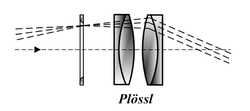Plössl eyepiece
The Plössl eyepiece in the history of optics, the first pure-colored microscope - and telescopic eyepiece . It has found widespread use due to its relatively simple design and low manufacturing costs.
It was invented around 1840 by the Viennese optician Simon Plößl (1794–1868) and 50 years later it was the occasion for a further development by Zeiss co-founder Ernst Abbe to the orthoscopic eyepieces.
The Plössl eyepiece consists of two achromatic (cemented) lenses that look towards each other with their convex surfaces. The achromatic lenses ensure a high degree of color purity , the arrangement of the 4 lenses ensures a good field of view with only minor edge distortions.
They are available today with focal lengths of around 4 to 40 mm. Mostly they are built with an outside diameter of 1 1/4 inches (approx. 32 mm), which is the most common size of the receptacle of telescopes.
Today almost all telescopes used by amateur astronomers are equipped with Plössl eyepieces as standard. In some cases they are supplemented by more expensive wide-angle eyepieces . They are also predominantly used in microscopy and for binoculars .
An important further development is the Erfle eyepiece , in which the front achromatic lens has a smaller focal length and a converging lens is inserted behind it. This allows it to be designed as a wide-angle eyepiece with a field of view of up to 70 °.
